Here’s a follow-up question from Mommy Denise:
Q: Hi again, teacher tanya! Thank you for the article you wrote on spending quality time with my toddler. It made me reflect on how I should give him the space and freedom to play. Sometimes, I’m not sure if I’m talking too much while he’s playing, I just can’t help myself from not interrupting, to be honest. Can you give me specific steps that I can remember and keep as a mental note whenever I’m with my son during his play time?
A: Hi again! It’s not really easy to implement child-led play or uninterrupted play at home. It’s never easy to accept that your child does not need to be entertained all the time. We think that our baby or toddler is missing a lot when we are just letting them be. Little do we know that we are actually depriving them of that one activity that gives them joy- and that is PLAY.
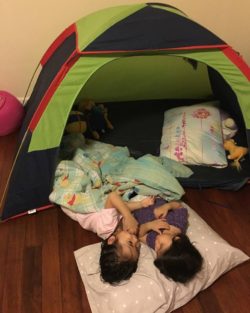
A part of their play room that encourages time for reflection. It’s more of their alone space. I’ve noticed how their play becomes more slow-paced whenever they are in this space.
Yes, it is difficult at FIRST but as you keep on practicing it, making it part of your child’s routine, and encouraging everyone in your family to be onboard with you, it will get easier.
I remember when I was raising Ellie and Julia, I would get questions such as: “Hinahayaan mo lang sila sa mat? Okay lang ba yun?” At first I would get quite offended but I’ve learned through time that these questions are simply out of concern and curiosity. I reply by saying: “Yes, try observing them and tell me what you think.” Most often than not they would say, ” Wow, their attention is admirable. Kaya pala nila aliwin sarili nila.”
The best part of it is that you get to relax more, as Magda Gerber (the proponent of RIE®) would say, “…and enjoy the wonders of infant development“.

Infants.. they grow up way too fast.
Remember, your role is crucial in making your child’s play possible. Your role is to facilitate your child’s play, you are the Play Facilitator. This means that your goal for your baby/toddler is to be the initiator of play and not the other way around.
In my recent article: “How do I spend real quality time with my toddler”, I listed the numerous benefits of enabling your child to play naturally. Knowing that play can make your child into a WHOLE child- a child who is not just physically and intellectually well but also emotionally stable, I hope it has convinced you enough to start advocating for PLAY to be part of your child’s life.
I came up with 5 points that will serve as your mental notes in becoming a PLAY Facilitator:
- Set-up an environment that promotes PLAY.
Keep in mind that a child will not be able to freely explore if he/she does not have an environment that encourages movement and discovery. It is important to make sure that the play environment is safe, thus child-proofed. Magda Gerber pointed out that when your child feels secure in an environment, then it will definitely promote confidence in your child- to explore, to move around, and to interact with others. Wouldn’t you want a confident child?
Make sure that your play environment is not overstimulating. Make sure you have a variety of simple play objects that are age-appropriate. Know which are appropriate for a baby and those hat are more apt for a toddler. (Check my article: Baby and Play Series on this blog for the list of age-appropriate materials):
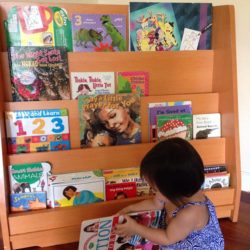
Set-up a play area indoor
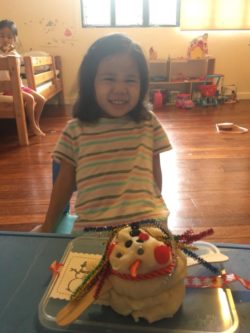
Provide open-ended materials
These play objects should invite initiative on the part of the baby/toddler. Magda emphasised the importance of the right toys by saying, “the simpler the toy, the more a child must use her imagination. Simple objects help children discover how things work”.
David Elkind, a child psychologist and author of popular books, such as: The Hurried Child” mentioned that simple toys that are open-ended (blocks and clay) allow not just creativity but also “personal expression”.
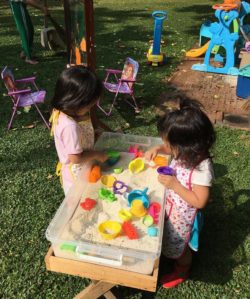
Set-up an outdoor play area too if you can:)
2. Wait until your child invites you to play.
Given that uninterrupted play is part of your routine, refrain yourself from interrupting your child’s play unless he/she invites you to join. Joining your child’s play may mean that she wants your presence or reassuring presence. You can be with your child but try not to influence what she is doing during this time. When you are invited for play, your child might want to give you a toy and take it back, or may ask you to read a book for her, and that’s perfectly okay.
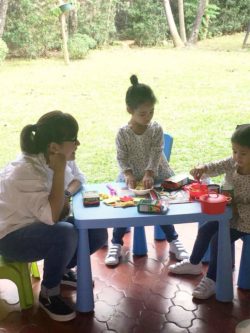
Wait for their invitation for play
Some attitudes that we need to be conscious of are the following: 1) Showing your child what to play with; 2) Teaching your child how to play with a particular object; Remind yourself that teaching a young child means taking that joy of discovery away from her and hinders your child from inventing it himself.
3. Observe, observe and observe
In a RIE parent-infant/toddler class, a big part of the class is observation time. Parents who are joining the class for the first time, find it awkward to be in a shared silence with other parents in the group. My parents in my own program would say that it was so challenging to simply watch and enjoy their infants/toddlers explore in class.
Why do we put emphasis on Observation Time? It is because through observing your infant that you get to know more about him-his cues, his interests, his preferences. Ruth Anne Hammond, a infant specialist and RIE practitioner, wrote in her book (Respecting Babies), that “if observation time does not happen for some reason on a given day, parents and teachers never feel quite as well connected to the children.” Ruth Anne adds, this silence, that undivided, open-ended attention that parents give to their children allows them that “getting to know the children in this deep way, enfolding them in the circle of attention, almost feels sacred. They (children) have learned something about how to pay attention, by having attention paid to them.”
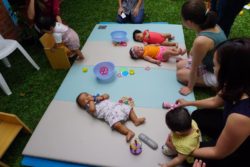
Our parent-infant class
When you observe, you simply sit down, and watch your child explore his environment. I would take down notes and just write what I see. Some parents would video-tape their child. It’s so much refreshing to read on what my child is doing, rather than observe but with this lingering question: “what can’t he do yet?” which leaves me rather worried and pressured.
4. Let your child figure it out.
Whenever your child gets in a difficult and challenging situation, do not provide a quick and easy fix, and do not rescue right away. Instead, give your child the opportunity to figure out a way through this situation. For example, when a ball that a mobile infant is playing with rolls under the blanket, and that infant starts to cry. What do you do? You don’t pick up the ball and give it to your mobile infant. Instead, you let your infant (who can actually already crawl or cruise or walk even) to pick up the play object. Trust that your child is able to go through that process of “doing it herself/himself”
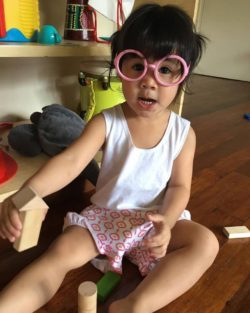
Let them figure out. Trust that they can do it!
5. Comment by Reflecting
Our goal for our child is to let her inner joy to be self-motivating. This means that you don’t really need to keep on praising a child for every action. Doing so would encourage your child to have a performer seeking attitude and it would definitely disrupt a child’s learning experience. Have you seen your child be distracted by someone who shouted loudly out of sheer excitement because you child walked for the first time?
Praise can come in different forms: words such as: Very good, good girl, good boy or a loud clap or excessive compliments. I’m not saying that saying these words are not good, but how we use them and how often we use them can impact a child’s behaviour. If we use them without any purpose at all, then it would definitely influence our child to have this “performer mentality”.
Our goal is to enjoy what our child can do.
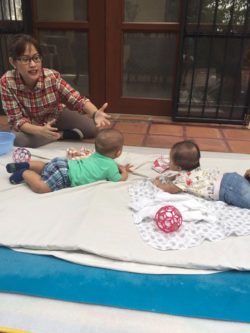
Comment on what your child can do and is doing.
Magda Gerber called it: Reflecting. When you reflect, you comment your child’s actions. By doing so, you mirror your child’s point of view and it affirms the valuable process of self-discovery. Some examples would be: Thanking your child rather than praising her. You can say: “thank you for being patient today. I know it’s hard for you to wait when you want to play already.” or another could be ” you were able to lift boxes. that seemed very hard.” When you reflect, you describe what your child is engaged in. You can say, “You are placing your things inside your bag.”

Magda Gerber emphasised that, “Reflecting acknowledges, informs and illuminates. This is how a child learns by starting to understand connections between things. It is a statement of support that allows your child to learn.”
Again, these are the 5 things that you must do in order that you get to support your child’s play. Remember that it’s never easy to simply relax, and let your child be the initiator during play, but keep in mind that by doing so, you are able to embrace the wonder of raising an infant and toddler. You get to enjoy what your child can do because before you know it, they are not babies or toddlers anymore. Most importantly, be assured that you are indeed supporting one of the many things that really gives so much Joy to your child, and yes, that is PLAY.


Comments are closed here.